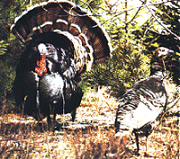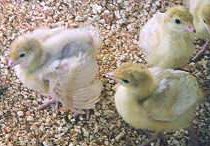All About Turkeys
Turkey Activities for Kids and Teachers
| Farm Animals | HOMEPAGE | Teacher's Corner |
| Kid's Corner | Holidays & Celebrations | Other Themes |

|
The wild turkey was first discovered in America. The turkey is native to Northern Mexico and Eastern United States. They were domesticated by the Aztecs in Mexico about 500 years ago. They were taken to Europe in the early 16th Century. The most common breeds in the United States are the Bronze, "White Holland, Narragansett, and the Bourbon Red.

The turkey is the largest bird on the farm. The male turkey is called Tom or cock.
The female is called a hen and the baby is called a poult.
A young male is called Jake while a young female is called Jenny. The male turkey
has a long wattle at the base of the bill and additional wattles on the neck.
Turkeys are omnivores. They feed on insects, plants, corn, wheat and seeds.
It also has a prominent tuft of bristles projecting downwards from its chest. The male will raise its tail feathers to form a vertical fan shape when it is courting the female. It also does this when as a show of aggressive display towards its enemies. As it grows older, it also gets more aggressive. The males get into fights among themselves for access to the hens or females. Male turkeys are also more colorful than the females, like most birds. Their plumage comes in a variety of bronze, green or reddish colors. The chest feather on the males are coarse. Wild turkeys can fly. They fly and roost (sleep) in trees.

However, commercially bred turkeys are usually white. Their colors have been purposely bred out because the pigment from the feathers would discolor the turkey's skin during dressing. They cannot fly because their breast are thicker and heavier.
Turkeys do not like water and the cold. Commercially bred turkeys are kept warm with heat lamps. In the wild, turkeys build their nests with dried leaves and grasses in places that are not easily seen on the ground. They can lay about 9-18 eggs in a clutch (a set or cluster of eggs). Their eggs look creamy white with red-brown speckles all over. Baby turkeys or poults live in a brood (group of young birds/fowl).

Turkey meat is very popular during certain festivals in certain countries, like Thanksgiving in the United States and Christmas dinner in most European countries.
| WORKSHEETS | Color and name the turkey pair
Teachers may also use it as a clipart Number Turkey Number sequence Read and color the -ur- wordlist. Phonics Reading -ur- sounds Think and write words with -ur- sounds Phonics Reading -ur- sounds |
| CLIPARTS & GRAPHICS | Clipart
Thanksgiving turkey in black outline. Thanksgiving graphics |
| TEACHERS |
Print out the -ur- sound wordlist. Phonics Reading -ur- sounds The Perpetual School Lesson Plan - Thanksgiving games Ontario Turkey : Education For teachers - get educational materials from them |
| MORE ACTIVITIES |
Pinecone turkey craft VAN AKEN ARTIST COLORS FOR ALL AGES Hands or Turkeys? - Fall Project Theresa's Paper Turkeys Heather says: "Find Tom Turkey" Game |
DISCLAIMER : This is a disclaimer. We try to gather information that are
as accurate as possible. However, if there are mistakes, we will not be held
liable for anything. Use it at your own discretion.
IMPORTANT : We are not responsible for any links beyond our site.


